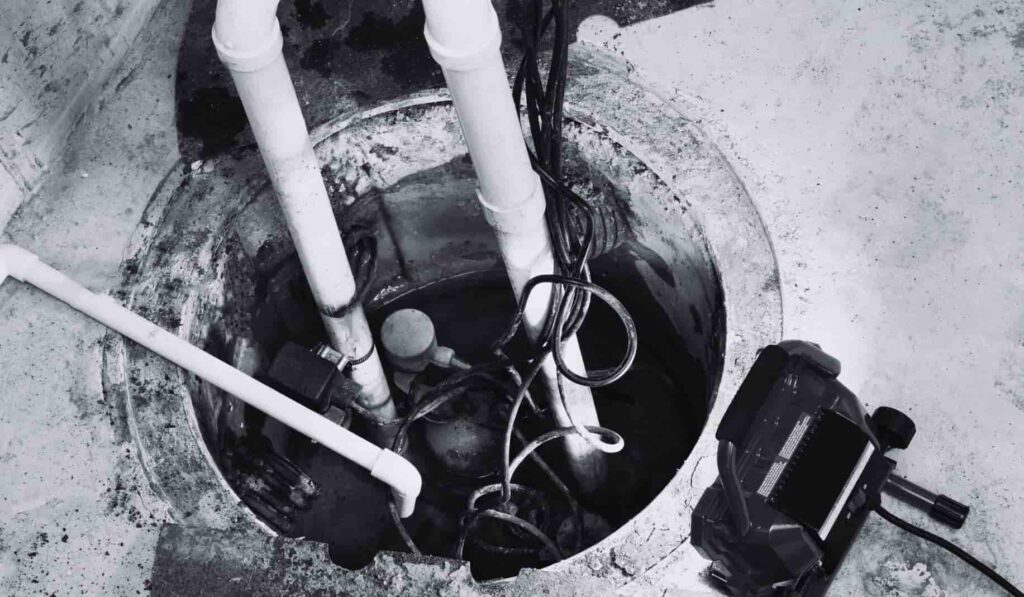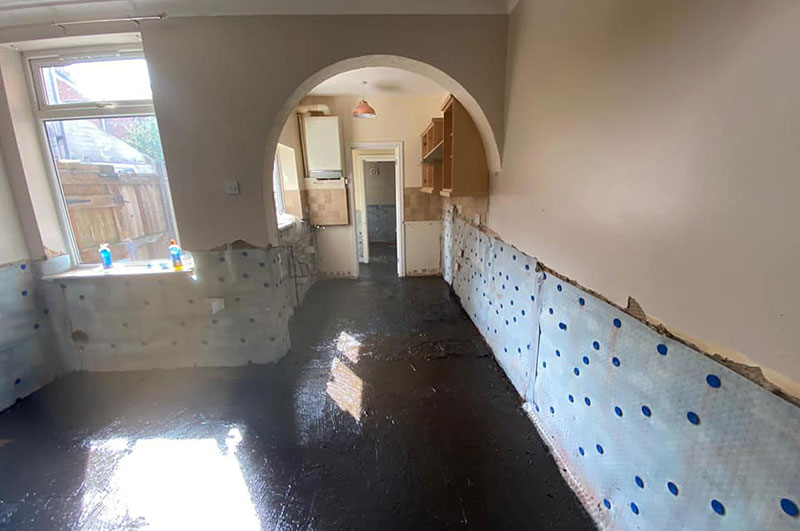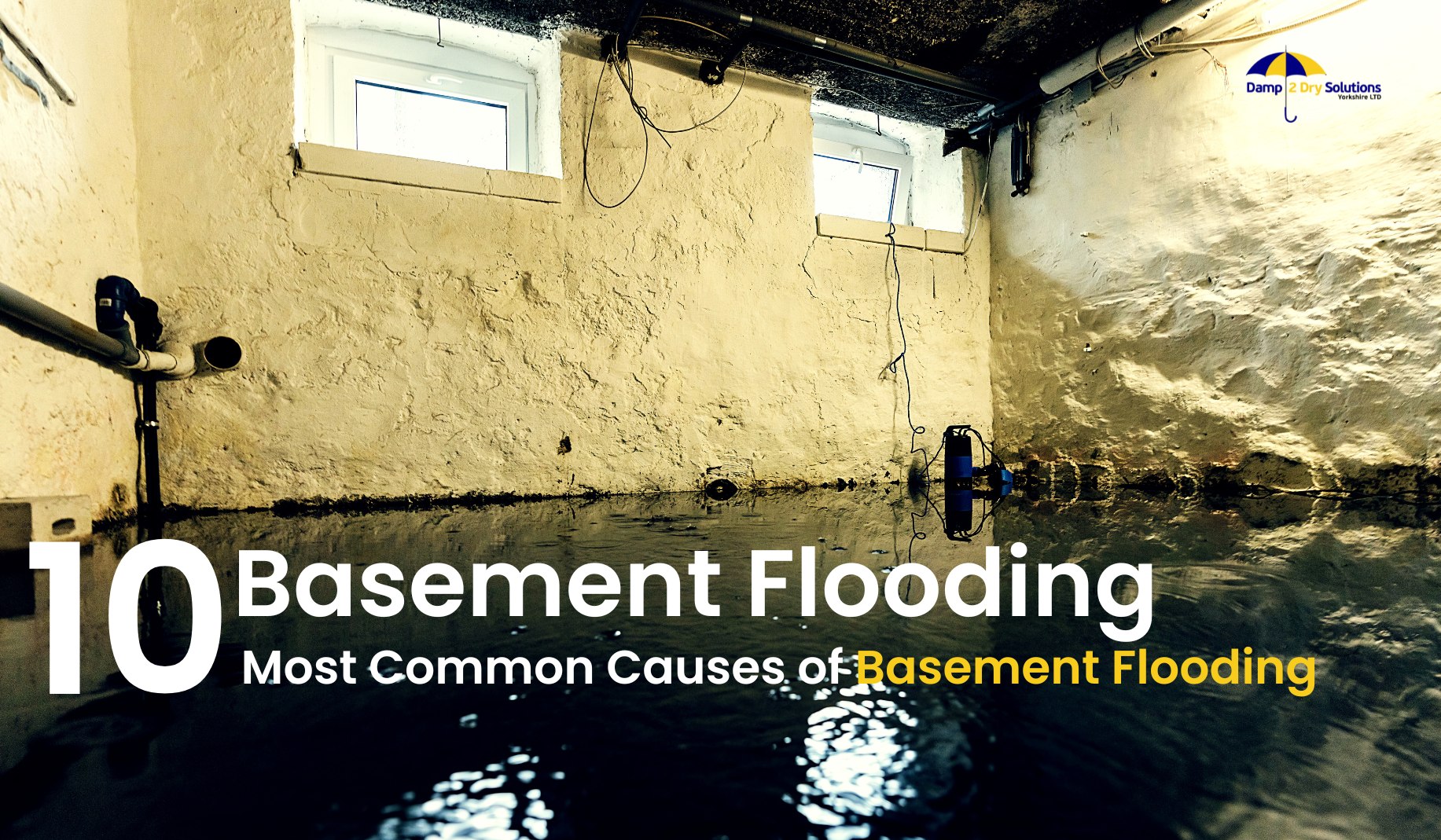Basements flood for numerous reasons, often due to environmental conditions, infrastructural deficiencies, or specific issues related to the property itself. Gaining an insight into why basements are vulnerable to flooding is critical for UK homeowners aiming to protect their properties.
Here, in this blog we will go through all the possible causes, supplemented with real-world examples and additional details, to shed light on how to prevent basement flooding.
1. Inadequate drainage systems

A leading reason for water flooding in basements is insufficient or obstructed drainage systems. When rainwater or melting snow cannot flow away from your property efficiently, it may seep into your basement.
The winter floods of 2013-2014 across Southern England illustrated the chaos that can ensue when drainage systems fail to cope with heavy rainfall.
Flood defence strategies
To keep your home safe from floods, it’s important to do some simple tasks regularly. Make sure to clean out your gutters so they don’t get blocked by leaves and other stuff. This helps prevent water from spilling over and getting into your basement.
Also, check that the pipes that carry rainwater away from your house aren’t pouring it out too close to your walls. If they are, try to extend them further away.
You can also look into putting in French drains or changing the slope of your garden. These steps help guide rainwater away from your home, lowering the chance of flooding. By doing these things, you can help keep your basement dry and your home safe from water damage
2. Blocked or broken pipes
Blocked or broken pipes, whether within your property’s plumbing system or the municipal sewage lines, can lead to backflows or leaks that flood basements.
The 2017 London Fatberg incident, where a colossal sewer blockage was found, showcases the severe impact that blocked or broken pipes can have, including flooding in basements.
Safeguarding your basement
Avoid flushing non-biodegradable items and fats down the drains. Be vigilant for signs of blockage or damage and consider regular inspections by a professional to avoid such issues.
3. Faulty sump pumps

Sump pumps are installed to remove water that collects in a sump basin, usually found in the basement. However, if these pumps fail due to power outages, improper installation, or lack of maintenance, the water level can rise and flood the basement.
A malfunctioning sump pump, often due to power failures, can lead to water flooding basements. Insurance data indicates numerous claims for basement floods result from sump pump issues.
What you can do about faulty sump pumps?
A sump pump is crucial for keeping your basement dry by pumping out water that collects in the sump basin. However, like any mechanical device, it can fail, especially during the times you need it most, such as during heavy rainfall or power outages. Here are steps to ensure your sump pump remains reliable:
- Test Regularly: Perform checks every few months to confirm it’s working properly, particularly before heavy rain seasons.
- Battery Backup: Equip your sump pump with a battery backup to guarantee operation during power cuts, a common occurrence during storms.
- Maintenance: Keep the sump pit and inlet screen clear of debris to avoid clogs that can impair the pump’s functionality.
- Professional Check-Up: Consider an annual inspection by a specialist to ensure the system’s optimal performance and address any potential issues.
4. Improperly sealed basements
Over time, the sealant on basement walls and floors can deteriorate, allowing water to infiltrate through cracks and gaps. This was evident following Yorkshire’s heavy rains in 2015, where many homeowners reported leaks.
Preventive measures
Inspect your basement annually for any signs of moisture and reapply sealant as needed. Consider professional waterproofing solutions for better protection.
5. High ground water levels
In areas with high ground water levels, especially after prolonged periods of rainfall, water can pressure basement floors and walls, leading to seepage.
High groundwater levels, as experienced in the Somerset Levels, pose a continuous risk of seepage and flooding. The winter floods of 2013-2014 prompted significant investment in drainage infrastructure to combat this issue.
Preventive measures
Installing a sump pump system, applying interior and exterior waterproofing methods, and ensuring proper drainage can help manage the risk.
6. Poor property grading
One common cause of basement flooding is poor property grading. If the land around your property slopes towards your house rather than away, rainwater will naturally pool around your foundations and potentially flood your basement.
This was highlighted during Storm Ciara in 2020, with homes having poor grading suffering the most.
Preventive measures
Reshaping the land to ensure a downward slope away from your property and installing landscape features that divert water can significantly reduce the likelihood of flooding.
7. Overwhelmed local drainage systems

During heavy rainfall, local drainage systems can become overwhelmed, leading to surface water flooding.
Heavy rainfall, such as during Storm Desmond in 2015, can overload local drainage systems, leading to surface water issues and flooding in basements.
Storm Desmond broke the United Kingdom’s 24-hour rainfall record, with 341.4 mm (13.44 in) of rain falling in Honister Pass, Cumbria, on 5 December.
Source:- metoffice.gov.uk
Protective actions to take
While individual influence on public infrastructure is limited, supporting community initiatives for drainage improvements and installing personal flood defenses can offer some relief.
8. Leaks from appliances and HVAC systems
Water heaters, washing machines, and HVAC units are common sources of leaks that can lead to basement flooding if not detected early.
In 2019, a burst pipe from an old water heater in Manchester highlighted how appliance leaks can lead to water flooding in basement situations.
Preventive measures
Regular checks and maintenance of water-related appliances and systems can prevent such leaks. Installing water sensors can also provide early detection and mitigation.
9. Natural disasters
Flooding from natural disasters such as heavy rains, storms, or river overflows can be challenging to prevent. People from Storm Dennis can’t forget the year 2020, which impacted over 1,200 properties.
Strategies for flood avoidance
For those in flood-prone areas, sandbags, flood doors, and barriers can offer some level of defense against natural flooding events.
10. Foundation damage
Finally, damage to your property’s foundation, such as cracks or settling, can create pathways for water to enter your basement.
Damage to the property’s foundation can create entry points for water, as observed during the Hull floods of 2007. As per the Coulthard of Hull University they believe that over 8,600 homes and 1,300 businesses were flooded and tragically one person died in the events of 25 June.
How to shield your basement?

Foundation damage can significantly increase the risk of your basement flooding. Here’s how to manage and prevent such issues:
- Routine Checks: Schedule inspections of your foundation at least once a year. This helps spot any problems well before they turn serious.
- Spotting Cracks: Keep an eye out for any small cracks or signs of wear in your foundation. These can become entry points for water.
- Immediate Repairs: If you find any cracks, no matter how minor, get them fixed straight away. Delaying repairs can lead to bigger problems and potential flooding.
- Proper Drainage: Ensure your property has effective drainage solutions in place. Water should always be directed away from your foundation to avoid pressure that can cause cracks.
- Landscaping: Consider the land around your home. Trees and plants should be far enough away so their roots don’t grow into the foundation.
- Professional Advice: If you’re unsure about the state of your foundation, or if you spot significant damage, seeking advice from a structural engineer can provide peace of mind and a clear action plan.
To Sum Up
Basement flooding is a multifaceted issue with various contributing factors. By understanding these common causes and learning from past incidents, property owners in the UK can adopt proactive measures to protect their basements from unwanted water flooding.
This not only secures the property from the flood but also avoids the considerable inconvenience and expense associated with dealing with flood in basement aftermath.
About Us
Are you tired of dealing with the stress and damage caused by basement flooding?
Damp2Dry Solutions (Yorkshire) Ltd. is here to safeguard your property against water intrusion. Specialising in state-of-the-art basement waterproofing and water damage restoration services, we’re dedicated to providing peace of mind for homeowners throughout Yorkshire.
With our expert team, cutting-edge technology, and personalised approach, we ensure your basement remains dry, secure, and comfortable all year round. Don’t let water damage disrupt your life; trust Damp2Dry Solutions to keep your basement protected and pristine.
Contact us today to discover how we can tailor our solutions to meet your specific needs.



